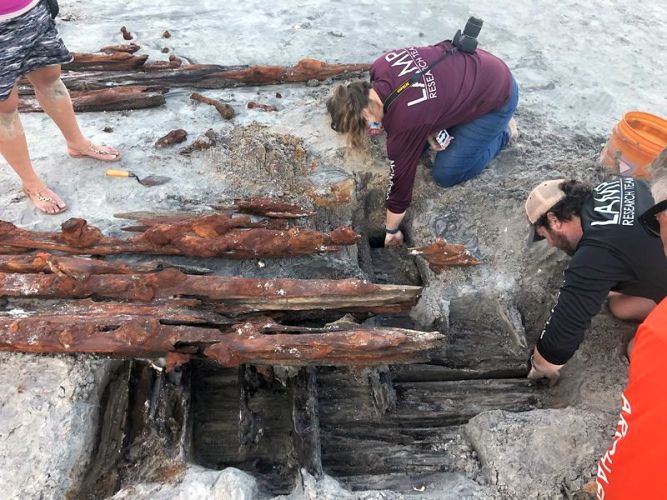Shipwreck Exposed by Erosion on Florida Coast Could Be 200 Years Old
Mark O’Donoghue was walking on Crescent Beach in St. John’s County on Saturday, as he does almost every day, when he saw “some timbers and metal spikes” sticking up through the sand. O’Donoghue reached out to the St. Augustine Lighthouse Archaeological Maritime Program (LAMP), which sent researchers to investigate. After assessing the site, the team determined that they’d stumbled onto the wreckage of a vessel that likely ran aground on Florida’s northeast coast during the 19th century, when Crescent Beach looked decidedly different.
“The sand dune wasn’t here when the ship wrecked,” archaeologist Chuck Meide tells First Coast News. “We know topography and the landscape of a coast changes a lot." He speculates that a storm eventually pushed the shipwreck far up on the beach, where sand formed around it. Based on the wooden timbers and iron fasteners, Meide tells Ryan Nelson of Action News Jax that the vessel was most likely a merchant ship.
“It was probably a cargo ship, carrying goods, again in the 1800s,” he says. “Think of it kind of like a Walmart semi-truck: a ship that was carrying a bunch of, could be hardware, could be flour, could be all kinds of different commodities.” Budsberg outlines several possible scenarios that could have brought the ship to the spot where it sat for centuries. “It might have been at the end of its life, and they ran it up on the beach and called it a day,” he says. “Or it is possible it wrecked further out to sea and a portion of the ship made it to the beach.
The archaeologists also found burn marks on some of the ship’s timbers. “My gut is telling me the burning happened after the ship wrecked,” Meide tells First Coast News. “Someone very well could have burned it for salvage purposes because then you shift through the ashes and pull out metal spikes and sell for scrap.”
But the discovery also has a dark side: It reflects the growing problem of beach erosion, a natural phenomenon exacerbated by climate change. Pat Lee, who lives near the spot where the shipwreck was discovered, tells First Coast News that the ship only became visible due to the massive loss of beach sand in recent years. “The wreckage there used to be under ten feet of sand,” he says. “In the last three years, we lost it. We lost it all. … It’s very cool to see the shipwreck. It is very disturbing to see the sand leave our beach.”
https://www.smithsonianmag.com/smart-news/shipwreck-exposed-florida-coast-could-be-200-years-old-180976351/

